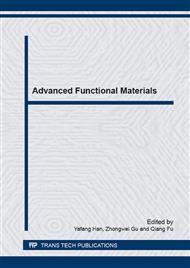[1]
S.P. Murarka., Multilevel interconnections for ULSI and GSI era, Mater. Sci. Eng. 19(1997) 87-151.
DOI: 10.1016/s0927-796x(97)00002-8
Google Scholar
[2]
M. Hansan, J.F. Rohan., Cu electrodeposition from methanesulfonate electrolytes for ULSI and MEMS applications J. Electrochem. Soc. 157(2010) D278-D282.
DOI: 10.1149/1.3332729
Google Scholar
[3]
K.N. Tu., Recent advances on electromigration in very-largescale-integration of interconnects, J. Appl. Phys. 94(2003) 5451-5473.
DOI: 10.1063/1.1611263
Google Scholar
[4]
C.C. Yang, P. Flaitz etc, Co capping layers for Cu/low-k interconnects, Microelectron. Eng. 92(2012) 79-82.
Google Scholar
[5]
H. Kim, T. Koseki etc, Cu wettability and diffusion barrier property of Ru thin film for Cu metallization, J. Electrochem. Soc. 152(2005) G594- G600.
DOI: 10.1149/1.1939353
Google Scholar
[6]
L. Zhang, M. Kraatz etc, in Proceedings of the IEEE 2010 International Interconnect Technology Conference IITC, (2010) 1.
Google Scholar
[7]
B. Zhao, T. Momose, Y. Shimogaki., Deposition of Cu–Ag alloy film by supercritical fluid deposition, Jpn. J. Appl. Phys. 45(2006) L1296-L1299.
DOI: 10.1143/jjap.45.l1296
Google Scholar
[10]
Hino, M., Nagasaka T. and Takehama, R., Activity measurement of the constituents in liquid Cu-Mg and Cu-Ca alloys with mass spectrometry, Metall. Mater. Trans. 31B (2000) 927.
DOI: 10.1007/s11663-000-0069-0
Google Scholar
[11]
K. Lewin et al., Thermodynamic study of the Cu-Mn system, Scan. J. Metall. 22(1993) 310.
Google Scholar
[12]
Jacob, K. T.; Priya, S. and Iseda, Y., Thermodynamic study of the Cu-Mn system, Z. Metallkd. 91(2000) 594.
Google Scholar
[13]
Oyamada, H., Nagasaka, T. and Hino, M., Activity measurement of the constituents in liquid Cu-Al alloy with mass-spectrometry, Mater. Trans. Vol. 12(1998), 1225.
DOI: 10.2320/matertrans1989.39.1225
Google Scholar
[14]
Witusiewicz, V, Arpshofen, I and Sommer, F., Thermodynamics of liquid Cu-Si and Cu-Zr alloys, Z. Metallkd. 91(2000) 594.
DOI: 10.1016/s0040-6031(00)00502-5
Google Scholar
[15]
Katayama, I., Shimatani, H. and Kouzuka, Z., Thermodynamic Study of Solid Cu-Ni and Ni-Mo Alloys by E. M. F. Measurements using the solid electrolyte, J. Jpn. Inst. Metall. 37(1973) 509.
DOI: 10.2320/jinstmet1952.37.5_509
Google Scholar
[16]
Azakami T., Yazawa. A., Activity measurements of liquid copper binary alloys, Can. Metall. Quart. 15(1976) 111.
DOI: 10.1179/cmq.1976.15.2.111
Google Scholar
[17]
Koike, J. and Wada, M., Activity measurements of liquid copper binary alloys, Appl. Phys. Lett. 87(2005) 041911.
Google Scholar
[18]
Koike. J., Haneda. M. etc, Activity measurements of liquid copper binary alloys, J. Appl. Phys. 102(2007) 043527.
Google Scholar
[19]
J. Iijima, M. Haneda, J. Koike, Growth Behavior of Self-Formed Barrier Using Cu-Mn Alloys at 350 to 600 °C, IEEE. 6(2006) 155-157.
DOI: 10.1109/iitc.2006.1648675
Google Scholar
[20]
Usui, T., Nasu, H. etc, Highly reliable copper dual-damascene interconnects with self-formed MnSixOy barrier Layer, IEEE Trans Electron Devices. 53(2006) 2492.
DOI: 10.1109/ted.2006.882046
Google Scholar
[21]
Peijun Ding, Tony Chiang etc, U.S. Patent 0, 034, 126. (2001).
Google Scholar
[22]
W.A. Lanford, P.J. Ding etc, Low-temperature Passivation of Copper by Doping With Al or Mg, Thinsolid films. 262 (1995) 234-241.
DOI: 10.1016/0040-6090(95)05837-0
Google Scholar
[23]
Vladimir M. Segal, Wuwen Yi etc, U.S. Patent 0, 072, 009. (2004).
Google Scholar


